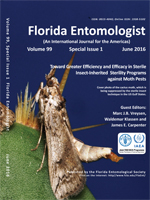Marc J. B. Vreysen, Waldemar Klassen, James E. Carpenter
Florida Entomologist 99 (sp1), 1-12, (1 June 2016) https://doi.org/10.1653/024.099.sp102

KEYWORDS: biological control, colonization, Competitiveness, mass-rearing, irradiation, dispersal, field performance, mating status, modeling, mating compatibility, mating competitiveness, flight ability, cold adaptation, cage studies, open field studies, female attractant, host-derived kairomone, conspecific larvae-infested host, marking, natural isotope signature, Control biológico, colonización, competitividad, cría en masa, irradiación, Dispersión, desempeño en el campo, modelado, compatibilidad del apareamiento, competitividad del apareamiento, estado del apareamiento, capacidad de vuelo, adaptación al frío, estudios de jaula, estudios de campo abierto, atrayente de hembras, kairomona derivada del hospedero, hospederos infestados con larvas conespecíficas, marcado, firma de isótopos naturales
Lepidopteran species are amongst the most damaging pests of food and fiber crops world-wide. Pest lepidopterans are often managed injudiciously by spraying crops with large amounts of broad-spectrum—and often—persistent insecticides. In view of increased occurrence of resistance against these insecticides, and their negative impacts on the environment and ecosystems, the need for control tactics that are not only effective but also friendlier to the environment is becoming more and more pressing. Both the sterile insect technique (SIT), and the related inherited sterility (IS) technique offer great potential as additional control tactics for integration with other control methods in area-wide integrated pest management approaches against lepidopteran pests. However the SIT/IS can only be applied successfully when the released sterile insects can effectively compete with their wild counterparts for mating with wild females. Although there are a number of programs where the SIT has been used very effectively against key lepidopteran pests, there is great potential for further expansion of the SIT/IS technology to target other key lepidopteran pests, or to improve the SIT/IS for already targeted Lepidoptera. Such expansion could be facilitated through improvements of mass-rearing, measurement and control of quality, handling, irradiation, shipping, release and field assessment technologies that would increase program efficiency and efficacy. To foster such advances, the Joint FAO/IAEA Division of Nuclear Techniques in Food and Agriculture, implemented a Coordinated Research Project (CRP) from 2008 to 2014 entitled “Increasing the efficiency of Lepidoptera SIT by enhanced quality control”. This Project organized and sponsored research and development on the following key objectives: (1) identify and investigate factors and variables affecting the quality of the produced and released insects and their field performance, (2) identify and develop new tools and methods to assess and predict the field performance of sterile insects, and (3) improve the artificial rearing of several moth species through a better understanding and management of genetic resources. The key research outputs of the CRP are summarized in this paper.

